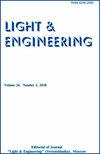小型风力涡轮机在道路照明中的应用
IF 0.3
4区 工程技术
Q4 ENGINEERING, ELECTRICAL & ELECTRONIC
引用次数: 0
摘要
在本研究中,研究了用于道路照明的灯具的能源消耗,这是由小型风力涡轮机提供的。作为应用区域,Bitlis- rahva地区是Bitlis市中心的新定居点。在这项研究中,每10分钟用数据记录器记录一次代表道路灯杆10米高度的风力数据(持续1年)。在文献中的许多研究中,威布尔分布被用于风数据的分析和风能潜力的确定。由此可见,该方法的精度较高,因此对于用于道路照明的小型风力发电机的发电容量选择威布尔分布。采用极大似然法确定威布尔密度函数的参数。考虑到灯杆的尺寸和它们所能承载的负荷,我们得出结论,在这些灯杆上使用小型垂直轴风力涡轮机发电是合适的。已经确定,道路灯杆上的风力涡轮机产生的能量远远超过灯杆上的灯具所消耗的能量。本文章由计算机程序翻译,如有差异,请以英文原文为准。
Use of Small-Scale Wind Turbines in Road Lighting
In this research, it has been studied energy consumption by luminaires, used in road lighting, which is providing by small-scale wind turbines. As the application area, the Bitlis-Rahva region, which is the new settlement of the city centre of Bitlis, was chosen. For the study, the wind data at a height of 10 m representing the road lighting poles were recorded with a data logger every 10 minutes (for 1 year). In many studies in the literature, the Weibull distribution has been used in the analysis of wind data and determination of wind energy potential. It has been seen that the accuracy of this method is high and therefore the Weibull distribution is chosen for the power generation capacity of the small-scale wind turbine to be used in road lighting. The maximum likelihood method was used to determine the parameters of the Weibull density function. Considering the dimensions of the lighting poles and the loads they can carry, it was concluded that it would be appropriate to use small-scale vertical-axis wind turbines for energy generation on these poles. It has been determined that the amount of energy produced by the wind turbine on the road lighting pole is much more than the luminaire on a lighting pole will consume.
求助全文
通过发布文献求助,成功后即可免费获取论文全文。
去求助
来源期刊

Light & Engineering
ENGINEERING, ELECTRICAL & ELECTRONIC-OPTICS
CiteScore
1.00
自引率
50.00%
发文量
0
审稿时长
1 months
期刊介绍:
Our magazine
develops comprehensive communication within the lighting community, providing opportunities for discussion and free expression of opinions of specialists of different profiles;
contributes to the convergence of science and engineering practice, the search for opportunities for the application of research results in lighting and technological applications of light;
keeps the scientific community up to date with the latest advances in the theory of the light field, providing readers with operational professional information;
initiates international cooperation, promotes and distributes the results of Russian authors in the international professional community;
provides equal opportunities for authors from different regions of Russia and other countries.
The journal publishes articles in the following areas:
visual and non-visual effects of radiation on humans;
light field theory;
photometry and colorimetry;
sources of light;
ballasts;
light devices, their design and production technology;
lighting and irradiation installation;
light signaling;
methods of mathematical modeling of light devices and installations;
problems of energy saving in lighting, installation and operation of lighting installations;
modern production technologies of lighting products for lighting control systems;
innovative design solutions;
innovations in lighting and lighting design;
the study of the effect on plants and animals, problems of using light in medicine;
problems of disinfection of premises, water and smell elimination with the help of technology of UV radiation using;
problems of light in the ocean and space.
 求助内容:
求助内容: 应助结果提醒方式:
应助结果提醒方式:


